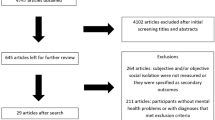Abstract
The authors describe uses for a 17-item instrument that efficiently measures the functioning level of chronically mentally ill persons living in the community. The Multnomah Community Ability Scale is designed to be completed by case managers who work with chronically mentally ill consumers. The instrument is sensitive to differences among individuals within this special population of consumers and is easy to complete. Community mental health program staff can be trained to use the scale reliably. The scale has been used to compare levels of severity between urban and rural community mental health program clients. The authors discuss the application of the Multnomah Community Ability Scale to a capitated payment system for severely mentally ill, involuntary clients.
Similar content being viewed by others
References
Anthony, W.A., Kennard, W.A., O'Brien, W.F., & Forbess, R. (1986). Psychiatric rehabilitation: past myths and current realities.Community Mental Health Journal, 22:249–263.
Barker S., Barron N., McFarland B.H., & Bigelow D.A. (1993). User's manual for the Multnomah Community Ability Scale. Program Analysis section, Office of Menthal Health Services, Oregon Mental Health and Developmental Disability Services Division, Salem, Oregon.
Barker S., Barron N., McFarland B.H., & Bigelow D.A. (1994). A community ability scale for chronically mentally ill consumers: part I. reliability and validity.Community Mental Health Journal, 30:363–382.
Bowling A. (1991).Measuring Health: a Review of Quality of Life Measurement Scales. Open University Press, Philadelphia.
Brekke, J.S. (1992). An examination of the relationships among three outcome scales in schizophrenia.Journal of Nervous and Mental Disease 180:162–167.
Cook, J.A. (1992). Outcome assessment in psychiatric rehabilitation services for persons with severe and persistent mental illness. Manuscript. thresholds National Research and Training Center on Rehabilitation and Mental Illness, Chicago, Illinois.
Corcoran K. and Fischer F. (1987).Measurements for Clinical Practice. Free Press, New York.
Damkot D.K., Pandiani J.A., and Gordon L.R. (1983). Development, implementation, and findings of a continuing client satisfaction survey.Community Mental Health Journal 19:265–278.
DeVellis R.F. (1991).Scale Development: Theory and Applications. Sage Publications, Newbury Park, California.
Dworkin R.J., Friedman L.C., Telschow R.L., et al. (1990). The longitudinal use of the global assessment scale in multiple-rater situations.Community Mental Health Journal 26:335–344.
Green R.S. & Gracely E.J. (1987). Selecting a rating scale for evaluating services to the chronically mentally ill.Community Mental Health Journal 23:91–102.
Horn S.D., Chambers A.F., Sharkey P.D. & Horn R.A. (1989). Psychiatric severity of illness: a case mix study.Medical Care 27:69–84.
Hornbrook M.C. & Goodman M.J. (1991). Health plan case mix: definition, measurement, and use.Advances in Health Economics and Health Services Research 12:111–148.
Mechanic D. & Aiken L.H. (1989). Capitation in mental health: potentials and cautions. In D. Mechanic and L.H. Aiken (eds.)Paying for Services: Promises and Pitfalls of Capitation. New Directions for Mental Health Services, Number 43, Jossey-Bass, San Francisco.
Pokorny L.J (1991): Client outcome variables collected within a management information system. In:Management Information Systems: Treatment Outcome Measurement. McGuirk FD and Sanchez AM (editors), Western Interstate Commission for Higher Education, Boulder, Colorado.
Schlesinger M. (1989): Striking a balance: capitation, the mentally ill, and public policy. In D. Mechanic and L.H. Aiken (eds.)Paying for Services: Promises and Pitfalls of Capitation. New Directions for Mental Health Services, Number 43, Jossey-Bass, San Francisco.
Spector P.E. (1992):Summated Rating Scale Construction: an Introduction. Sage Publications, Newbury Park, California.
Stahler, G.J. & Rappaport, H. (1986). Do therapists bias their ratings of patient functioning under peer review?Community Mental Health Journal, 22:265–274.
Sturt E. and Wyke T. (1987): Assessment schedules for chronic psychiatric patients.Psychological Medicine 17:485–493.
Susser, M. (1990): Disease, illness, sickness; impairment, disability and handicap.Psychological Medicine, 20:471–473.
Vaccaro JV, Pitts DB, and Wallace CJ (1992): Functional assessment. In: Handbook of psychiatric rehabilitation, Liberman RP (editor), Macmillan Publishing Company, New York.
World Health Organization (1988):WHO psychiatric disability assessment schedule (WHO/DAS), WHO, Geneva.
Author information
Authors and Affiliations
Rights and permissions
About this article
Cite this article
Barker, S., Barron, N., McFarland, B.H. et al. A community ability scale for chronically mentally Ill consumers: Part II. Applications. Community Ment Health J 30, 459–472 (1994). https://doi.org/10.1007/BF02189063
Issue Date:
DOI: https://doi.org/10.1007/BF02189063




